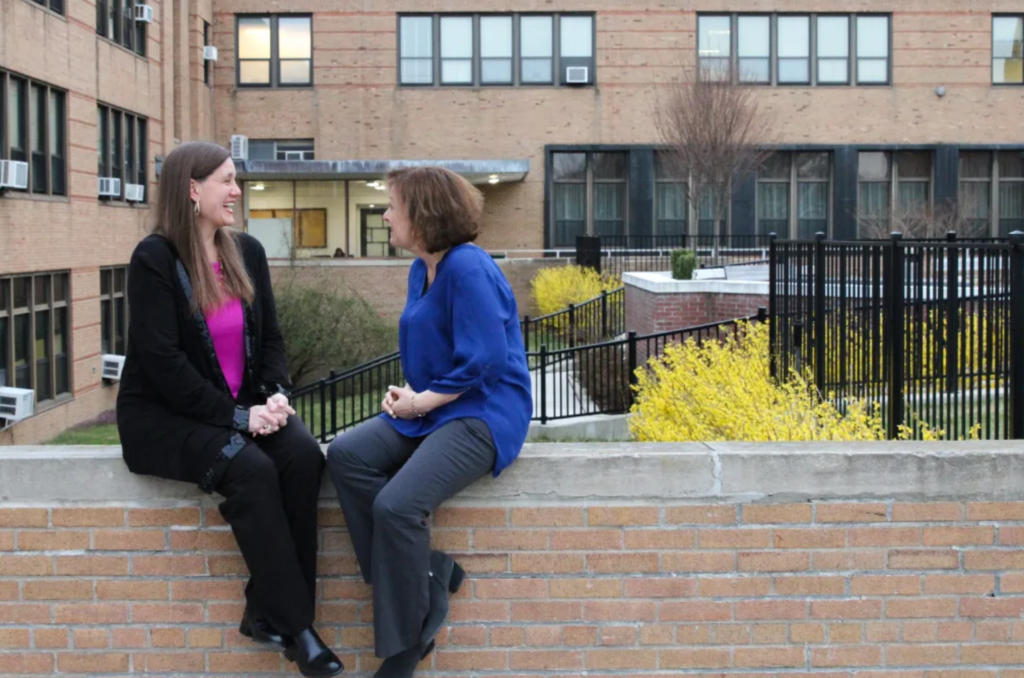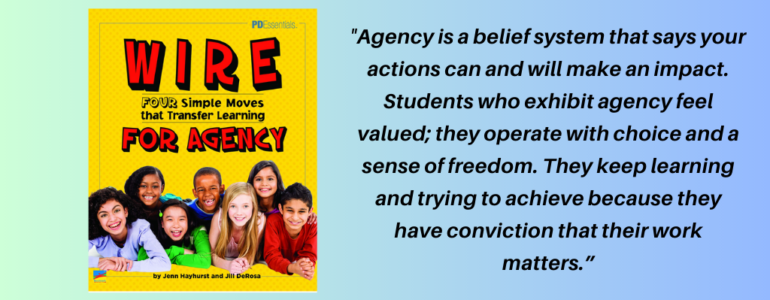By Jenn Hayhurst, & Jill DeRosa
Imagine entering a classroom where some students are working in small groups, others in partnerships, and some independently. There is a low but lively hum of students’ voices. Perhaps they are making plans for how to show their learning to the rest of their classroom community. Some might be negotiating the meaning of a text. Maybe they are conferring with another student about a learning goal. As all of this is happening, the teacher is moving freely through the classroom, keenly aware of how the space is functioning. Classroom supplies, tools, and charts are thoughtfully set up to provide easy access to all learners. The library is central to the function of the room and is reflective of students’ identities and interests. This classroom is a classroom built for agency.
Agency is one of those ubiquitous terms in education. It seems to be everywhere, it is part of every presentation, and yet, when pressed to define it, its meaning is somewhat elusive. In Peter Johnston’s seminal book, Choice Words, he defined agency as, “Children should leave school with a sense that if they act, and act strategically, they can accomplish their goals. I call this feeling a sense of agency.”
Johnston’s book, Choice Words, lent legitimacy to the authentic approaches to teaching and learning we believe in. Having a sense of agency holds the promise to empower all to learn with a sense of agency because our work matters, and everyone has the potential to make a positive impact. We believe agency makes it possible for learning to be joyful and celebrated by everyone in the learning community. In our book, WIRE for Agency Four Simple Moves that Transfer Learning, we expanded on Johnston’s definition: “Agency is a belief system that says your actions can and will make an impact. Students who exhibit agency feel valued; they operate with choice and a sense of freedom. They keep learning and trying to achieve because they have conviction that their work matters.”

Access, Language, and Choice: Three Core Beliefs to Sustain Agency
There are three core beliefs that sustain and nurture agency in the classroom. Giving access, careful deliberation for language, and offering choice are common beliefs shared by many teachers. However, these beliefs become even more powerful when used as a lens for agency:
- Access: Students get what is needed (independence, additional support, and time) to think.
- Language: Teachers use language as a vehicle to foster safety, empathy, equity, and trust.
- Choice: Students are given a choice to decide content, planning, strategy, and people to work with.
Realizing agency for teachers and students may be only one or two small tweaks away. One possible way to focus this work is to reflect on one aspect of the classroom environment. Let’s use the classroom library as an example:
- Access: Determine if the reading materials in the library are reflective of the students in the class. Some questions to evaluate access might be: “Do the text bands match the reading readiness of the students in this classroom?” “Do the books match their reading identities in terms of culture or interests?”
- Language: Determine if there is evidence of student voice within the library. Some questions to ask students might be: “Do the categories of the bins make sense to you?” “How can a person find a book they are able to read by themselves?” “What is the best part of the library? Why?” “How do you select a book for your book bin?” “How can the library be improved?”
- Choice: Determine if the classroom library is open-ended for student participation. Managing the library and book selection has traditionally been under the purview of the teacher. If you give students some choice for book selection, this small library becomes an important step towards agency. Giving students some choice for how the space will be used and managed is another step toward agency. Some questions to ask might be: “Is there evidence of student choice to influence in the classroom library?” If yes, “What is it?” If no, “What can be shifted to include more choice?”
For the purpose of this post, we used the classroom library as an example, but there are many aspects of the classroom environment that can be a mediator for agency. Here is a checklist that might be a useful tool to start this work.
Closing Thoughts

An agentive classroom does not have to be an imaginary place. Many classrooms already have a lot of what it takes to grant access to agency for learning. If you are tired of students asking for supplies, then try moving supplies where they can be readily accessed. If you are tired of students asking for clarifying directions, try using an anchor chart that students help to create using language they understand. If you are tired of students saying, “I’m done.” try giving them choice for what to do next. These small but significant tweaks will make your teaching and their learning even more meaningful if you give it a go. When we teach students to think flexibly about their classroom environment, it is but a stepping stone for them to challenge other “fixed” spaces in society. Life-long learners who are critical thinkers are who is needed for a better tomorrow. So start teaching for a sense of agency today.
Check out- WIRE for Agency: Four Simple Moves That Transfer Learning
![]()













